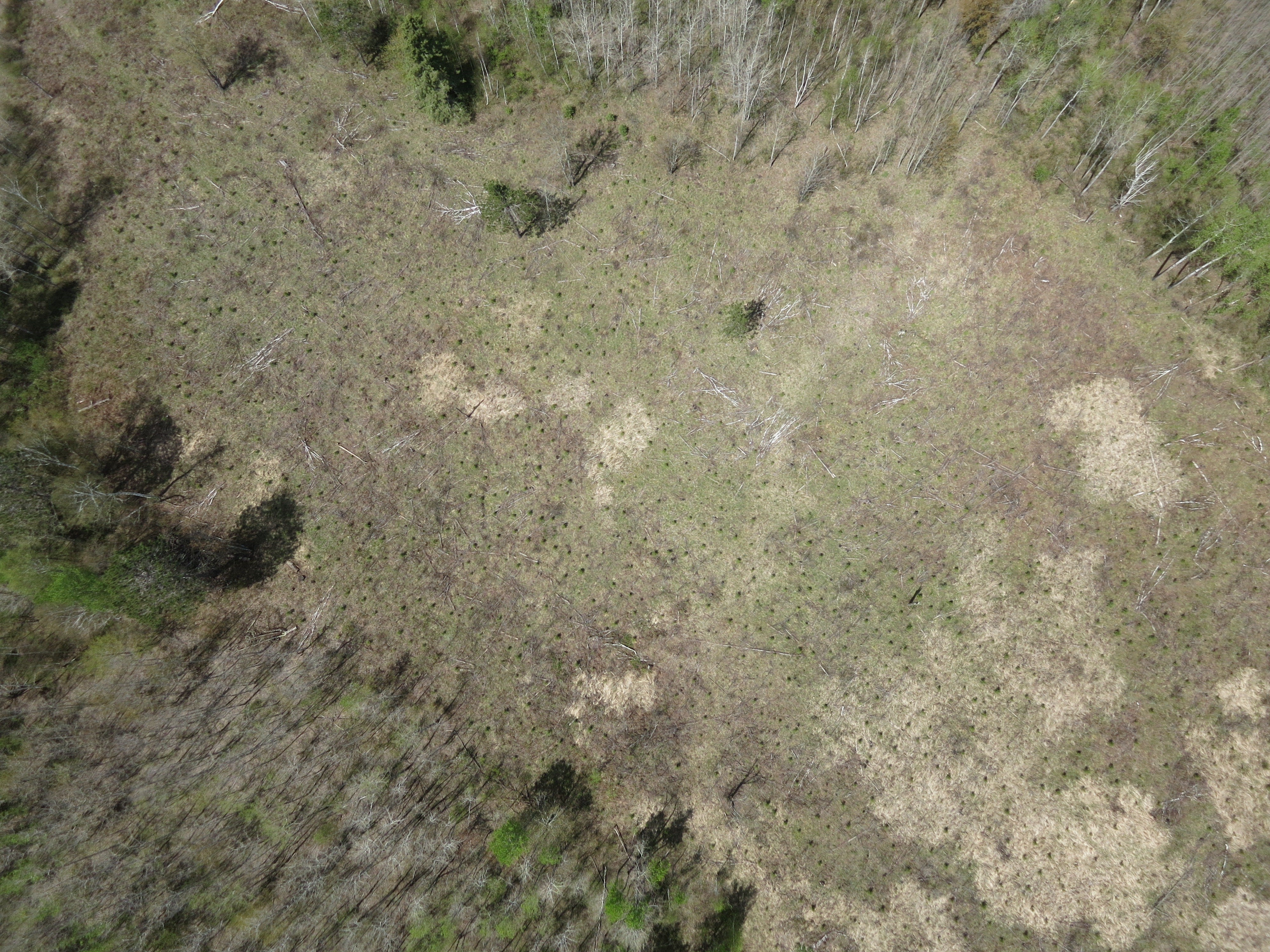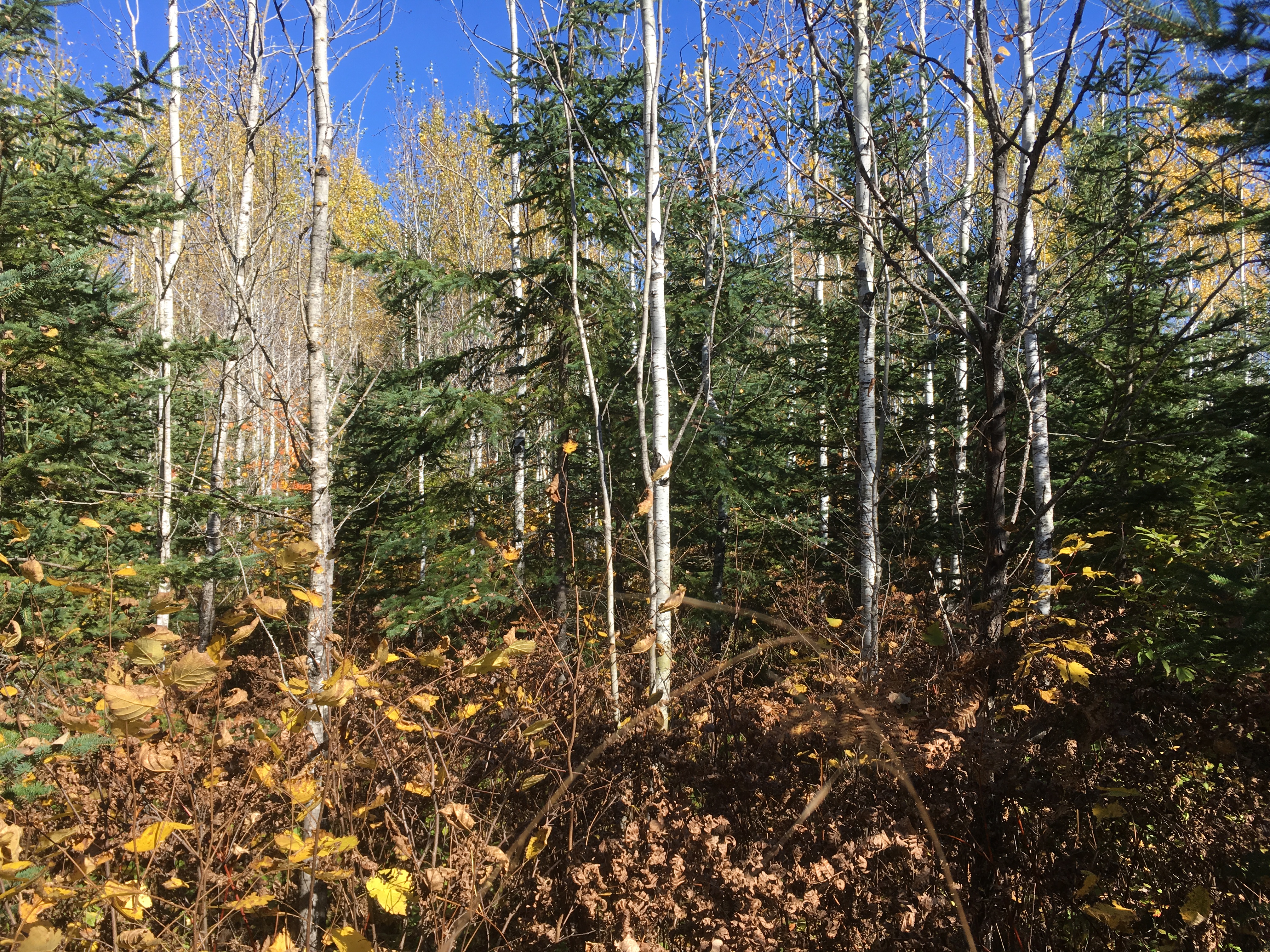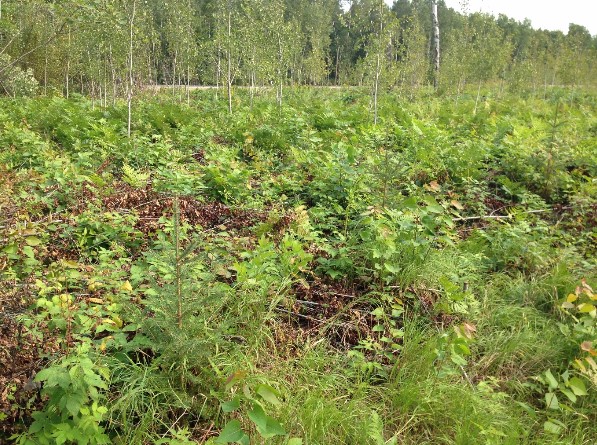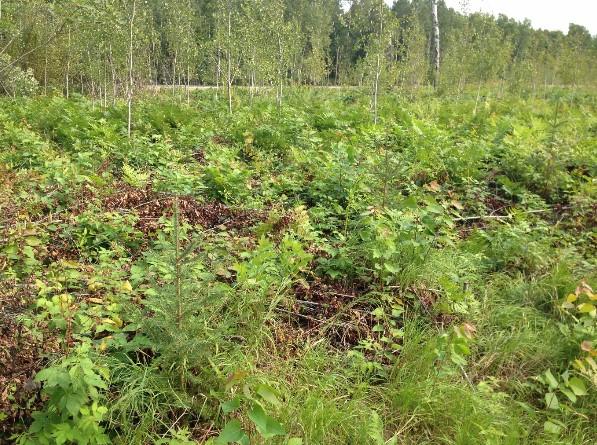Overview

Figure 1: An aerial view of the site taken by Dan Heinz using an eBee UAV, the photo was taken mid May of 2017.
Conifer species (white spruce, white pine, and red pine) were artificially introduced into a regenerating aspen stand post-clearcut to create an even-aged, mixedwood stand.
Silviculture Objective(s)
The objective of the treatment was to create an even-aged, mixedwood stand in place of the relatively pure aspen stand. This was done by planting containerized stock conifers after a clearcut so that the regenerating aspen would provide shade for the young conifer trees. Then, in order to release the growing conifers from competition, a brush saw release and aspen thinning was performed roughly 4 years after the initial planting.
Pre-treatment stand description and condition
Stand establishment and management history:
The previous stand, dominated by even-aged aspen, was established via a clearcut and managed as a coppice system to produce fiber. In a coppice system, stands are clearcut after each short rotation period and then allowed to regenerate vegetatively.
Pre-treatment species composition:
Even-aged aspen with some red maple and paper birch in the canopy and white spruce, balsam fir, and red pine creating a scattered super-canopy. Understory composed of patchy hazel.
Pre-treatment growth and stocking:
The pre-treatment stand was composed of young aspen grown in a coppice system and managed for maximum fiber production.
Pre-treatment forest health issues:
Pre-treatment stand was in good condition.
Landowner objectives/situation:
Supply sustainable and regular supplies of spruce and aspen timber for the local paper mill to use for pulp, fiber, and other wood products.
Silviculture Prescription

Figure 2: A photo of a site that received a similar treatment that is 18 years old, showing desired species composition and structure.
An even-aged aspen stand of 70 acres will undergo a clearcut harvest and further site preparation will be accomplished by clearing brush and roots with a roller chopper. Residual conifers in the super-canopy will be kept as reserve trees, as will aspen surrounding wetlands. Aspen and other deciduous trees will be allowed to regenerate naturally on the site, and three conifer species (white spruce, white pine, red pine) will be regenerated artificially by planting container-grown seedlings. In total, the conifer species’ stocking target is 500 stems/acre. After 4 growing seasons, aspen/deciduous species will be thinned down so that total stocking is 1200 stems/acre to increase growing space for establishment of the conifer saplings under their shade. After this release, no further early stand treatments will be planned and the conifers will be allowed to grow to rotation age, at which time they will be harvested for use by the mill.
What actually happened during the treatment
In summer of 2010, the stand underwent a mechanical clearcut to remove most of the aspen, with reserve areas left intact around wetlands and around the super-canopy pines. Roughly 25 cords were harvested from each acre. In the winter of 2010, site preparation was performed using a roller chopper to cut up brush and shallow roots before planting. In spring of 2011, the site was planted with three conifer species – white spruce, white pine, and red pine – at a total density of 519 stems per acre. Among these species, white spruce made up the majority at 475 stems/acre with red pine at 28 stems/acre and white pine at 16 stems/acre. The planted saplings came from containerized stock. In the summer of 2015, the planted conifers were released from the competition of nearby aspen regeneration by clearing a 4-foot radius around conifers with brush saws and by thinning the hardwood further until the total stocking for the stand was 1200 stems/acre.
Post-treatment assessment

Figure 3: White spruce saplings growing in a regenerating aspen stand.
After the treatment, aspen naturally regenerated across the stand, and some natural conifer regeneration occurred as well. The planted white spruce had a survival rate of roughly 85%. Three years after the planting, the artificially regenerated conifers made up 408 stems/acre, naturally regenerated conifers made up 9 stems/acre, and aspen and other deciduous trees made up 3933 stems/acre for a stocking total of 4350 stems/acre. Aspen and other deciduous trees were later thinned in 2015 so that the stocking total was 1200 stems per acre.
Plans for future treatments
The stand will continue to be managed to reflect a more natural and historical species mix of aspen/hardwoods and conifers. Due to the cost of release thinnings, aspen and other deciduous trees will not be thinned further in the future to promote growth of the planted conifers. Instead, a single release thinning will be planned at the beginning of each rotation of conifers in order to minimize the expense of tending the stand. Upon reaching rotation age, the planted conifers will be harvested and utilized by Blandin paper mill along with aspen.
Costs and economic considerations
It took about a year to clearcut the original aspen, prep the site, and plant the conifers, and an additional thinning occurred in 2015 after conifer establishment. Mechanical methods were used to clearcut the area and to prep it for artificial conifer regeneration. Equipment used included harvesting machines used to perform the cut-to-length clearcut of aspen, a roller chopper to prep the area, and brush saws to thin young aspen around growing conifers. Total cost (including site preparation, supplies, tree planting, and release thinning) for this type of stand conversion is between $375 and $525 per acre.
Summary / lessons learned / additional thoughts
In summary, the introduced conifers (mostly shade tolerant white spruce) have survived well during these initial six years of regeneration. The aspen has regenerated naturally, and so far one thinning has released the planted conifers enough to promote their continued growth and no further releases are planned. The increased species diversity in the stand reflects the mixedwood of conifer and hardwood that was historically present in the area. The stand will also have increased resilience to species-specific diseases/pests (spruce budworm, pine beetles, etc.) that can decimate a homogenous stand. Although the planted white spruce and red pine are not projected to fare better in this area as climate change continues, the stand as a whole will be more resilient to the negative effects of climate change due to its increased species diversity, which allows it to occupy a broader range of niches. From an economic standpoint, the increased species diversity will also allow for more stable timber revenue even as unpredictable changes to the climate occur.
